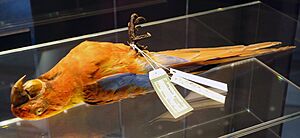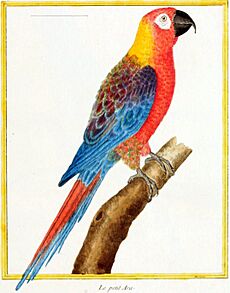Cuban macaw facts for kids
Quick facts for kids Cuban macaw |
|
|---|---|
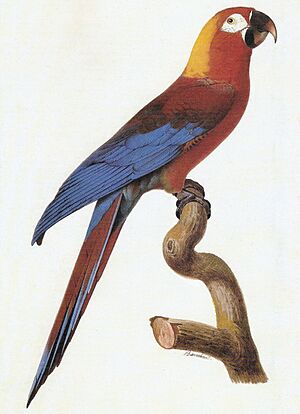 |
|
| Watercolour painting by Jacques Barraband, ca. 1800 | |
| Conservation status | |
| Scientific classification | |
| Genus: |
Ara
|
| Species: |
tricolor
|
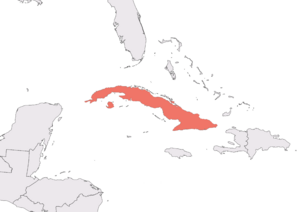 |
|
| Former distribution in Cuba, including Isla de la Juventud | |
| Synonyms | |
|
|
The Cuban macaw (Ara tricolor) was a colorful species of macaw that lived on the island of Cuba and nearby Isla de la Juventud. Sadly, it became extinct in the late 1800s. This macaw was one of the smaller types, growing to about 45–50 cm (18–20 in) long.
Its head was a mix of red, orange, yellow, and white. Its body showed shades of red, orange, green, brown, and blue. Not much is known about how it lived. However, reports say it nested in hollow trees and lived in pairs or family groups. It likely ate seeds and fruits. The Cuban macaw was found mainly in the large Zapata Swamp, where it lived in open areas with scattered trees.
People hunted and traded Cuban macaws for a long time. This happened with Native Americans and later with Europeans. Many macaws were sent to Europe as cagebirds. Today, only 19 museum skins of this bird still exist. The Cuban macaw became rare by the mid-1800s. This was due to hunting, trade, and its home being destroyed. Big storms like hurricanes might have also played a part. The last reliable sightings were in the 1850s on Cuba and in 1864 on Isla de la Juventud. It might have survived until 1885.
Contents
Discovering the Cuban Macaw
Early explorers like Christopher Columbus wrote about macaws in Cuba way back in the 1400s and 1500s. The Cuban macaw was described and drawn in several old books about the island. In 1811, a German scientist named Johann Matthäus Bechstein officially gave the species its scientific name, Psittacus tricolor.
Today, 19 skins of the Cuban macaw are kept in 15 different museums around the world. Some of these birds were collected by the Cuban scientist Juan Gundlach. He found some of the last macaws living near the Zapata Swamp in 1849–50. Some of the preserved birds had even lived in zoos or as pets.
Scientists have not found any full skeletons of modern Cuban macaws. However, they have found a few old bone pieces (called subfossils) in Cuba. These include parts of a wing bone, a beak, and a skull. These finds help us learn more about the bird's body.
Family Tree of Macaws
Scientists have suggested that many different macaw species once lived on the Caribbean islands. However, most of these ideas come from old drawings or descriptions. Only three Caribbean macaw species are known for sure from actual bone remains. These are the Cuban macaw, the Saint Croix macaw, and the Lesser Antillean macaw.
Macaws were often moved between islands and from South America to the Caribbean. This happened both in ancient times by Paleoamericans and later by Europeans. So, old reports of macaws on these islands might not always mean they were unique species. They could have been escaped pets. Sadly, humans likely caused all the native Caribbean macaws to become extinct.
For a long time, scientists thought the Cuban macaw was closely related to the scarlet macaw. This was because they looked similar, with red and blue feathers. However, a DNA study in 2018 looked at the genes of two Cuban macaw specimens. This study showed that the Cuban macaw was actually an older relative to both the large red macaws (like the scarlet macaw) and the large green macaws (like the military macaw).
The study suggested that the Cuban macaw separated from its mainland relatives about 4 million years ago. This was long after the land bridge connecting the Greater Antilles to South America disappeared. This means the ancestors of the Cuban macaw must have flown over the ocean to reach the islands.
What the Cuban Macaw Looked Like
The Cuban macaw had a bright red forehead that faded to orange and then yellow on the back of its neck. It had white skin around its eyes and yellow eyes. Its face, chin, chest, and belly were orange. The upper part of its back was brownish-red with green-edged feathers. Its lower back and tail feathers were blue. The wing feathers were brown, red, and purplish-blue. The top of its tail was dark red, turning blue at the tip. Its beak was described as dark or black, and its legs were brown.
Male and female Cuban macaws looked the same, just like other macaws. The Cuban macaw was smaller than its closest relatives. It was about 50 cm (20 in) long. This is about one-third smaller than the biggest macaws. Its wing was about 27.5–29 cm (10.8–11.4 in) long, and its tail was about 21.5–29 cm (8.5–11.4 in).
One scientist once said that young Cuban macaws were green. However, it's not clear where this idea came from. It's possible that green birds seen on the island were actually young Cuban macaws or perhaps escaped military macaws.
How the Cuban Macaw Lived
We don't know much about how the Cuban macaw behaved. One observer, Gundlach, said it made loud calls, similar to other macaws. He also reported that they lived in pairs or family groups. It was said that they weren't as good at copying human speech as other parrots. We don't know anything about their eggs or how they raised their young. However, one nest was found in a hollow palm tree.
The skull of the Cuban macaw suggests it ate hard seeds, especially from palm trees. This is similar to how large macaws on the mainland eat. In 1876, Gundlach wrote that the Cuban macaw ate fruits, seeds from the royal palm, and seeds from the chinaberry tree. It also ate other seeds and young plant shoots. Cuba has many types of palm trees, and those in swampy areas were probably very important for the macaw's diet.
In 2005, a new type of chewing louse (a tiny insect) was found on a museum skin of the Cuban macaw. This louse, called Psittacobrosus bechsteini, is thought to have only lived on the Cuban macaw. This is an example of coextinction, where one species dies out because another species it depends on also dies out.
Where the Cuban Macaw Lived
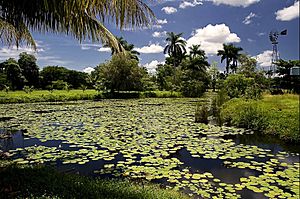
It's not clear exactly how far the Cuban macaw spread across Cuba when Europeans first arrived. By the mid-1800s, it was already becoming rare. Most reports from the 1800s come from Gundlach, who saw them often near the northern edge of the huge Zapata Swamp. By the 1870s, they were even rarer and had moved deeper into the swamp.
The Cuban macaw also lived on Isla de la Juventud, an island off Cuba. The last pair there was reportedly shot in 1864. Some old writers also claimed the macaw lived on Haiti and Jamaica, but this is not believed to be true anymore.
The Cuban macaw lived in open savanna areas with scattered trees. This kind of habitat is common in the Zapata Swamp. Cuba was once covered in many forests. However, much of this land has been cleared for farms and pastures.
Why the Cuban Macaw Disappeared
Hunting was a big reason for the Cuban macaw's extinction. Before Europeans arrived, Native Americans in the Caribbean hunted parrots, kept them as pets, and traded them. The Cuban macaw was said to be "stupid" and slow to get away, making it easy to catch. People hunted it for food. One traveler said the meat was tasty, but another thought it was tough. Old records show that Cuban macaws were hunted in Havana between the 1500s and 1700s. It might also have been hunted if it ate farmers' crops, even though it didn't live close to people's homes.
Many Cuban macaws were also caught and sent to Europe to be sold as pets. Perhaps thousands of them. This trade also helped cause their extinction. The large number of preserved specimens that were once pets shows that the species was probably common in European zoos and collections. It was a popular pet, even though it was known for damaging things with its strong beak.
Collectors would find young birds by watching the adult macaws. Then, they would cut down the trees where the birds nested. Sometimes, the baby birds were accidentally killed this way. This practice not only lowered the number of macaws but also destroyed their nesting places. This method of collecting birds still happens today with other Cuban parrots.
Big storms also played a role. A hurricane in 1844 is thought to have wiped out the macaws in one area of Cuba. More hurricanes in 1846 and 1856 further destroyed their homes in western Cuba. A tropical storm also hit the Zapata Swamp in 1851. If the macaw population had been healthy, these storms might have even helped by creating new habitats. But because the species was already struggling, the storms likely broke up their homes and forced them into areas where they were easier to hunt.
The exact date the Cuban macaw went extinct is not certain. The last reliable sightings were in the 1850s and 1864. However, some believe the species might have survived until 1885. Parrots are often among the first animals to disappear from an area, especially on islands.



